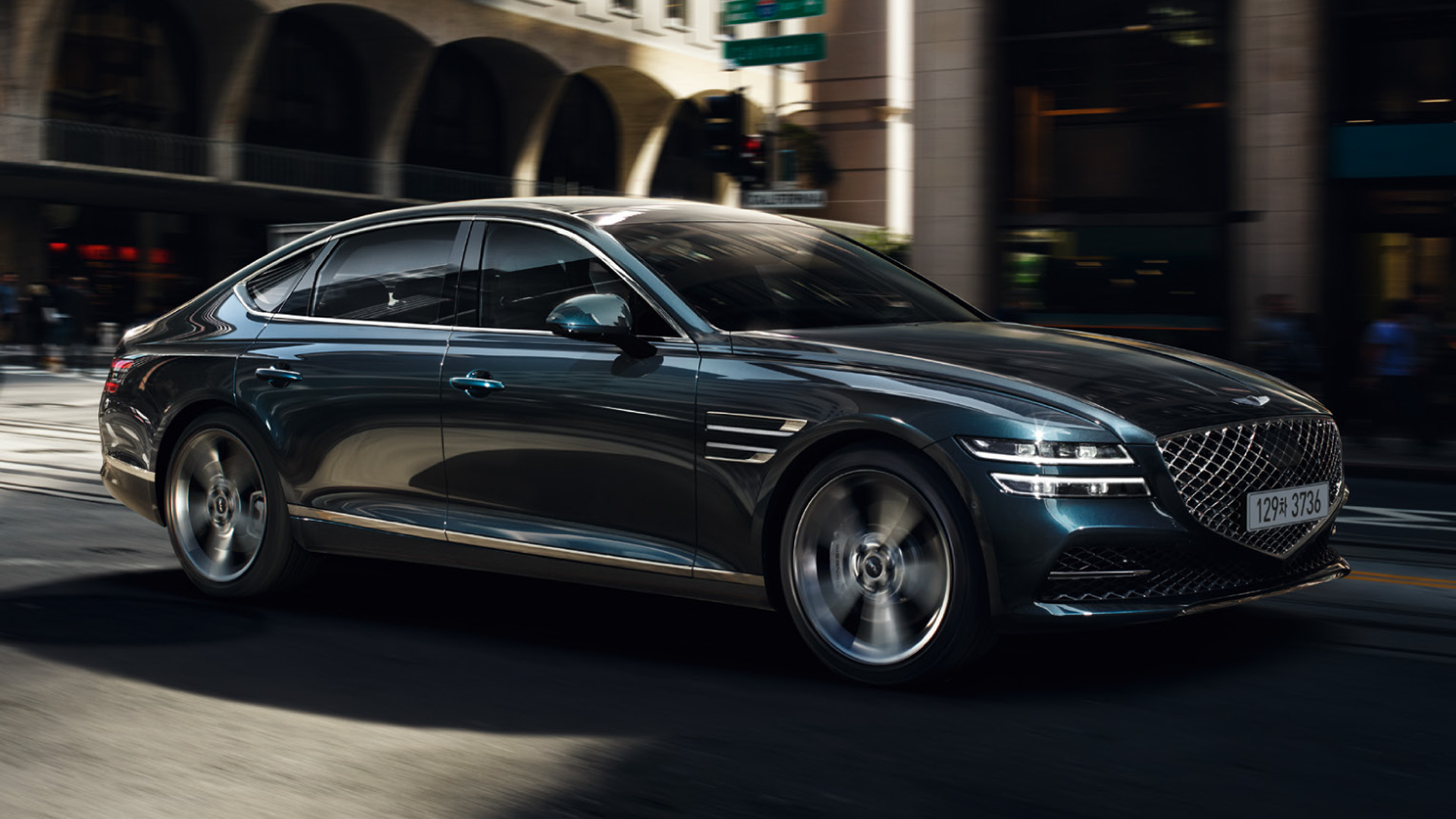
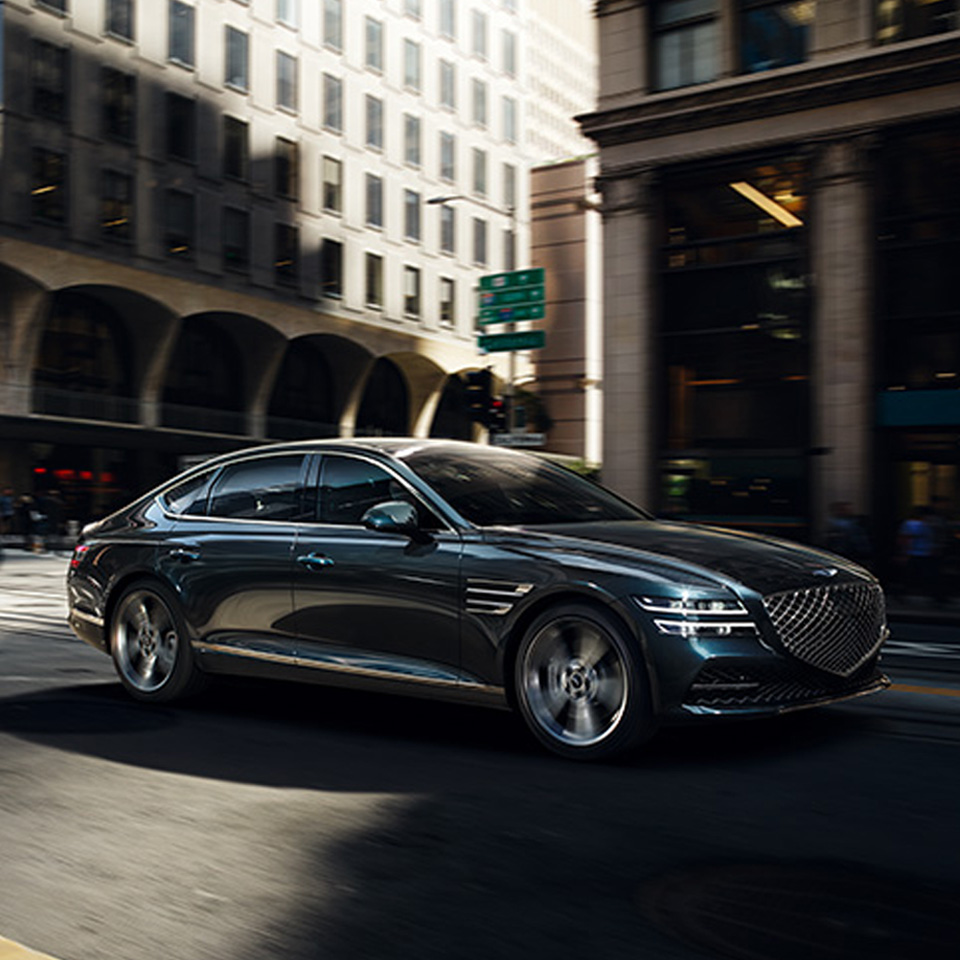


The title ‘luxury sedan’ is one that is not easily claimed. A luxury sedan ought to be sensually and aesthetically appealing; the material used ought to be of the highest quality; and it ought to offer cutting-edge convenience and safety features to support the passenger in both visible and invisible ways. But perhaps the most important requirement for the title is driving performance―the crucial index with which the brand’s technological capabilities are measured.
In this vein, a luxury sedan must above all perform well in the three fundamentals of driving: running, turning, and braking. In addition, it ought to boast a top-notch response rate, and offer reassuring driving comfort, free of noise, at all stages of driving. Indeed, the market’s demands for today’s luxury sedans are rigorous and exacting. That these demands must be met while satisfying the diverse tastes of individual consumers makes the challenge even more onerous for the car manufacturers.
And yet, the 3rd-generation Genesis G80 appears to have met the challenge in one meaningful way―it has managed to somehow offer both swift handling and noise-free driving comfort, which have historically been inversely proportional elements and thus a dilemma for all car engineers. We explore the Genesis engineers’ R&D efforts in devising the technology to overcome this dilemma.
The most influential factor in overcoming the dilemma was the completely revamped 3rd-gen rear-wheel-drive platform. Introduced first in the GV80, the 3rd-gen platform is intended for all Genesis models featuring the rear-wheel-drive capability.
The evolution into the new platform, in many respects the vehicle’s foundation, resulted in a variety of performance improvements. The average tensile strength underwent a 6% improvement over the previous generation’s; the lightweight material applied to the body and the chassis led to a 6.1% decrease of curb weight. Stronger yet lighter, the 3rd-gen platform served as the foundation for dramatically improving the comfort, handling, safety, and fuel economy of the Genesis line.
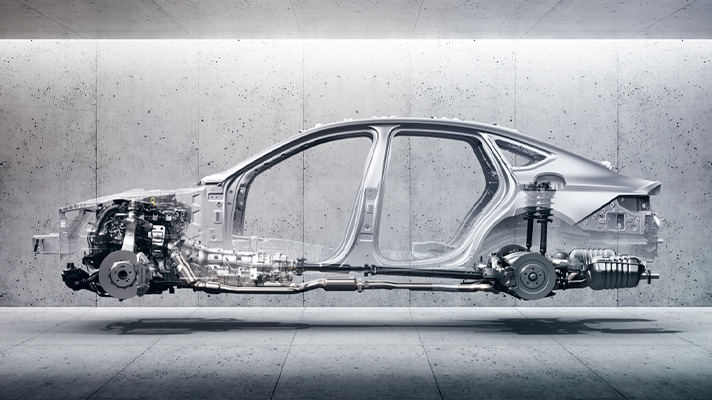
The platform offers another significant advantage: it is designed such that the heaviest parts of the car are placed as low as possible, in a so-called “low center of gravity” arrangement. With the powertrain positioned near the ground, the designers were free to pursue maximum elegance; the freed space allowed for more room in the passenger cabin, and the low center of gravity resulted in improved vehicle stability.
Specifically in the 3rd-gen G80, the position of the engine is 15 mm lower than the previous generation’s. With the heavy engine nearer to the ground, vehicle stability and handling at high speeds feel noticeably better. The seat positions of the front and the rear seats were also lowered by 5 mm and 15 mm, respectively, securing ample legroom and headroom in spite of the reduced total height of the vehicle.
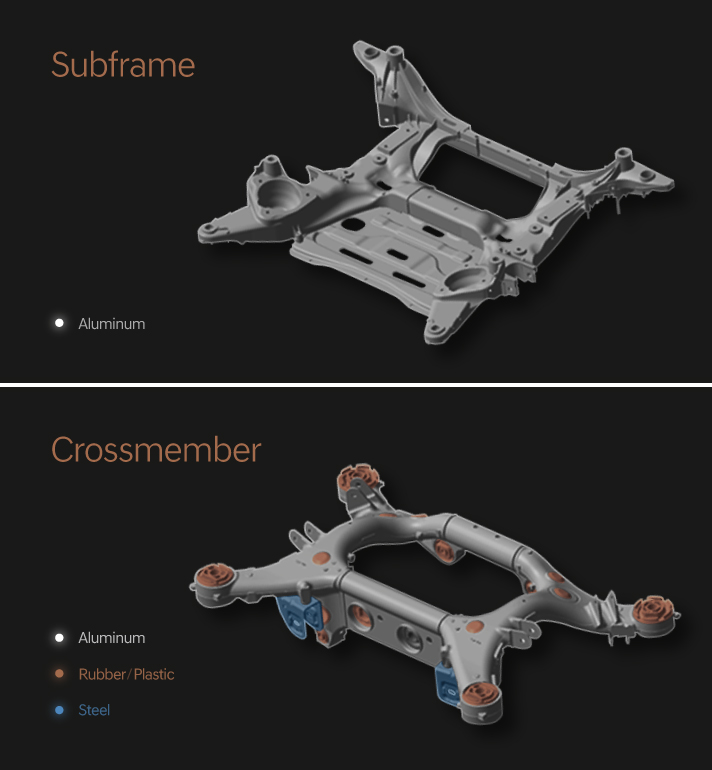
In addition, the material on the frontal subframe and the rear crossmember has been improved as well. The part of the frame on which the drivetrain is laid was made lighter through the application of aluminum. The cross-section of the subframe and the crossmember was also enlarged, resulting in improved stiffness. The choice of aluminum, a shock-absorbing material, also improves upon the vehicle’s NVH (Noise, Vibration & Harshness) performance.
In a more minute change that shows the meticulousness of the G80’s engineers, the diameter of the bush that connects the rear frame to the crossmember was enlarged from 80/85 mm to 100 mm. This was done to reduce the noise and vibration from the rear axle that is characteristic of rear-wheel-drive vehicles.
The suspension parts, now lighter with aluminum, correspondingly lower the unsprung mass*, ultimately resulting in improved tire traction, handling, and comfort, not to mention the reduction of total vehicle weight. Thanks to these structural and material changes, the 3rd-gen G80 boasts a curb weight that is a whopping 125 kg lower than the previous generation’s. This lower weight, of course, also has the benefit of improving the fuel economy and agility in handling.
*unsprung mass: the mass of the suspension, wheels/tires, and other components directly connected to (rather than supported by) the suspension.
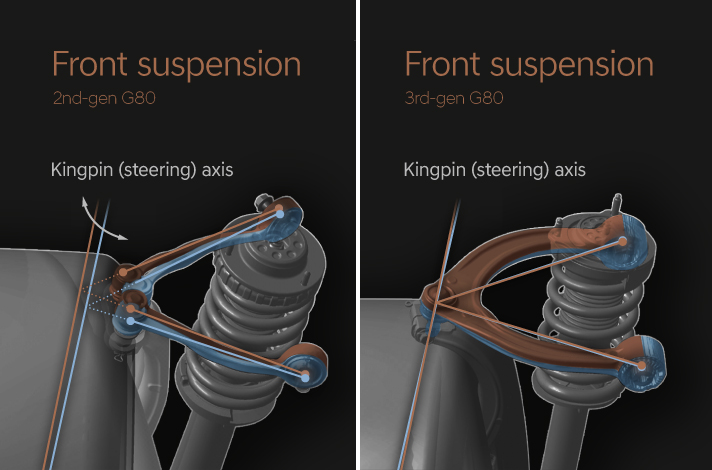
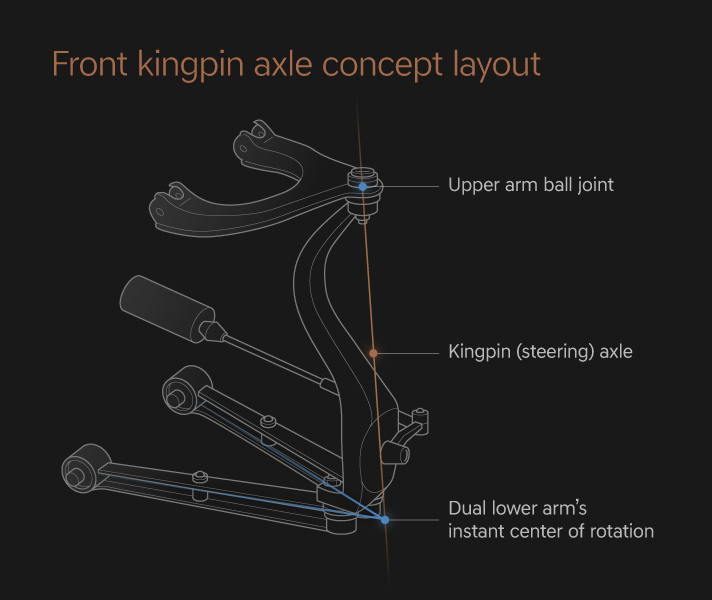
The suspension has also evolved. There are no structural changes―the 3rd-gen is still in the front/rear multi-link structure found in the 2nd-gen―but minute design adjustments resulted in meaningful improvements in driving comfort. The most noticeable change is in the upper arm of the front suspension, which changed from the dual-type to single-type. The simplified upper arm structure has the effect of reducing the movement of the kingpin axis*, around which the front axle connected to the wheel rotates. The kingpin axle thus undergoes less unwanted vibration, thus resulting in improved steering responsiveness and precision. The change also has the effect of reducing the unsprung mass, which again comes with improvements in driving comfort.
*kingpin axis: the hypothetical rotation axis determined by the geometry of the suspension’s lower and upper arms.
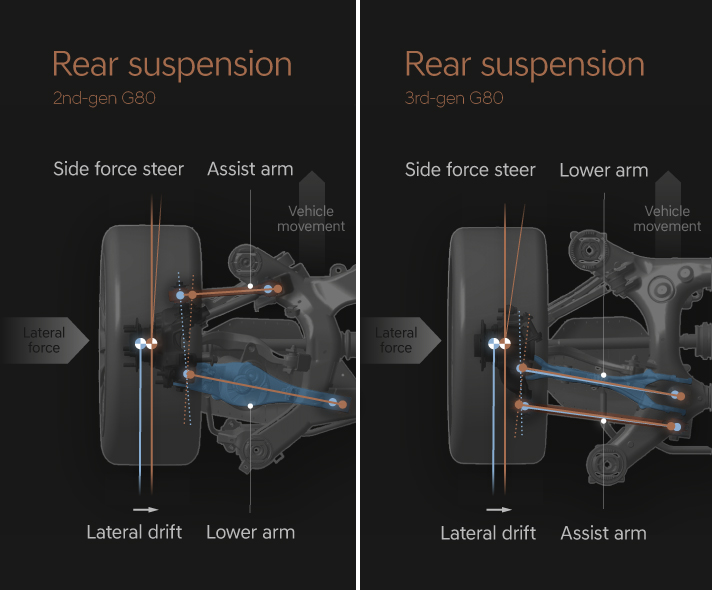
As for the rear suspension, the assist arm was moved to the rear side relative to the direction of vehicle movement. When a car turns a corner, the car’s rear axle needs to have sufficient lateral stiffness and response to side force steer* in order to steer stably. The movement of the assist arm to the rear improves the aforementioned lateral stiffness and side force steer responsiveness of the suspension, resulting in reduced vibration and improved driving stability.
*Side force steer: a phenomenon common during cornering in which the tire surface in contact with the road experiences a lateral force, which in turn is conveyed to the suspension and skews the direction of the tire’s progress. The phenomenon is especially common on rear tires due to the nature of rear suspensions.
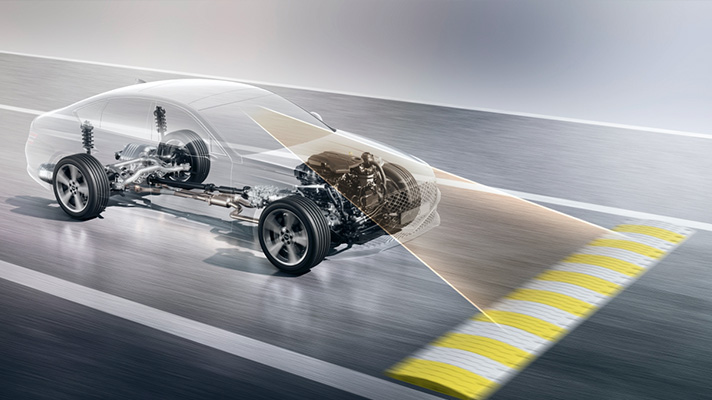
In addition to material and structural changes, the G80’s suspension is now also electronically controlled to secure maximal driving comfort. First introduced in the GV80, the technology uses the information from the forward-facing camera and the navigation to detect the surface conditions of the road ahead and reacts accordingly by adjusting the suspension’s damping force. Because it can preemptively react to speed bumps and potholes, the shock from the car body’s vertical movement is substantially reduced.
Structural changes in the front suspension―the distance between the steering rack and the kingpin axis was shortened―also resulted in improved steering responsiveness. Under normal circumstances, the shorter distance between the two parts results in the faster rotation of the tires and thus the better response to steering. In the 3rd-gen G80, this distance was shortened by 25 mm laterally and 47.5 mm vertically compared to the 2nd-gen’s. (Since the kingpin axis is a hypothetical axis conceived only for engineering purposes, we measured the distance from the rack to the wheel center, which is the kingpin axis’s approximate location. The axis is also three-dimensional, hence the two distance measurements.) These seemingly minute adjustments do add up to rather significant improvements in steering for the G80.
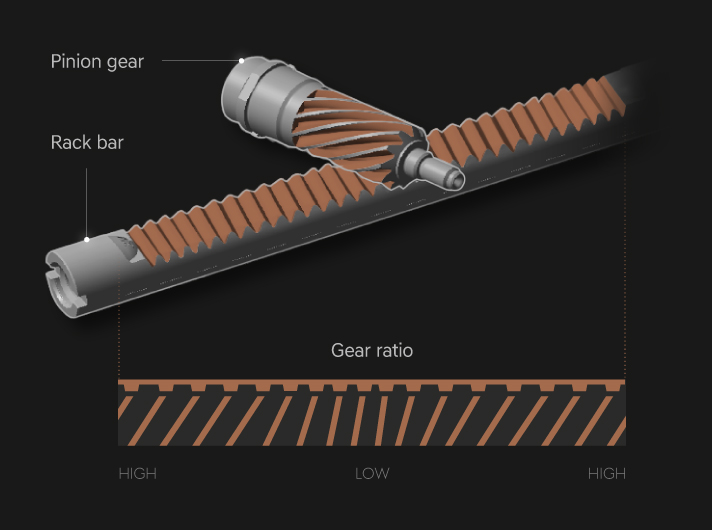
Lastly, the steering’s VGR (Variable Gear Ratio) was increased with the dramatic increase in steering performance in mind. The gear ratio here means the proportion by which the steering rack bar moves when the steering wheel is turned.
When the gear ratio is too high, the car becomes sensitive to even the smallest movements of the wheel; when the ratio is too low, the car feels unresponsive to the steering maneuvers. Thus, when the gear ratio is too high, high-speed travels become inherently unstable, as the car reacts to the small, unintended nudges on the wheel; when the ratio is too low, high-speed travel becomes stable but turning sequential short corners becomes an absolute chore.
VGR overcomes these tradeoffs, however, by employing a variable gear ratio. Essentially, it adjusts the gear ratio to the level ideal to the current course. While in straight high-speed movement, the gear ratio is decreased to secure stability; while in continuous curving, the gear ratio is increased to ensure steering responsiveness.
In the previous generation, the VGR’s variable range was set at 59-62 mm/rev, but the 3rd-gen G80 boasts the range between 66.5-74-63 mm/rev. The range is not only expanded but also set higher by default, which means that the car will react more quickly to the driver’s steering. Put the simplest: the steering will feel more agile in the new G80.
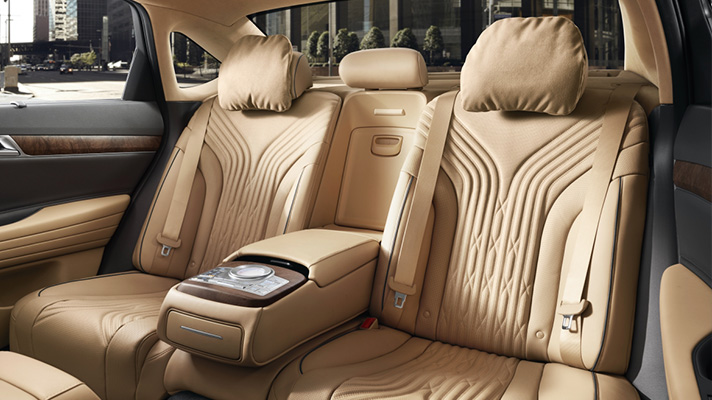
Another characteristic of the G80’s driving performance is just how tranquil the driving feels; noise and vibration that we almost unconsciously accept in cars feel minimal in it. The 3rd-gen G80 is home to a number of cutting-edge NVH-targeted technologies that seek to eliminate the vibration from the road and even the sound of the wind on the panel. The first parts to look into are none other than the aforementioned front subframe and rear crossmember.
Structural changes that make the subframe stiffer, as well as the enlarged cross-section of the rear crossmember’s bushings, reduce the noise and vibration coming up from the road surface. Typical surface noise and vibration experienced in the cabin comes from the tire’s friction with, or shock from, the various surface irregularities, which is sequentially conveyed to the passenger in the cabin through the tires, suspension, and the car body. This is why structural improvements in the platform (the subframe and the crossmember to be specific to this case) can result in an improved NVH performance.
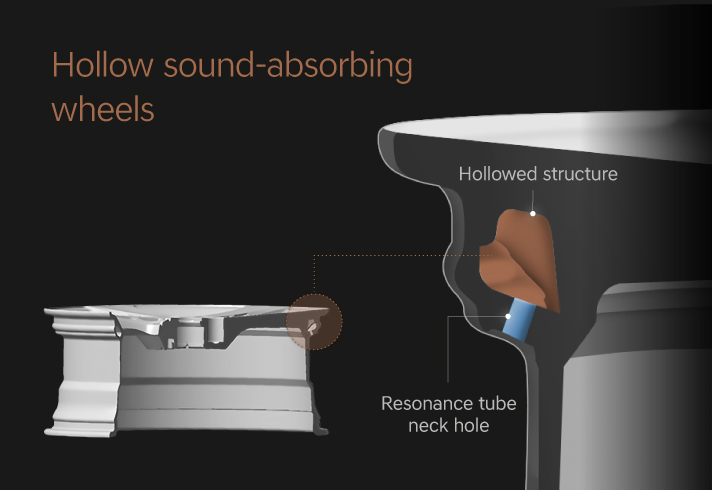
Another NVH technology applied to the G80 is the sound-absorbing wheels with hollow resonators, which have already proven to work in many premium cars.
The ‘resonance’ here means the sound pressure around 200 Hz band that occurs when the tire’s vibration during movement causes pressure changes in the hollow space between the wheel and the tire. This sound pressure is conveyed through the tire to the suspension and the car body, which in turn produces the unwanted vibration and noise for the passenger in the cabin.
Applied to all the sizes of wheels intended for the G80 (18-, 19-, and 20-inches), the sound-absorbing technology uses a Helmholtz resonator shaped like a rectangular pot to filter the resonation around the 200 Hz band―which, of course, is the approximate level produced by the road surface. The G80’s tranquil interior owes to many such NVH technologies applied to the wheels and chassis.
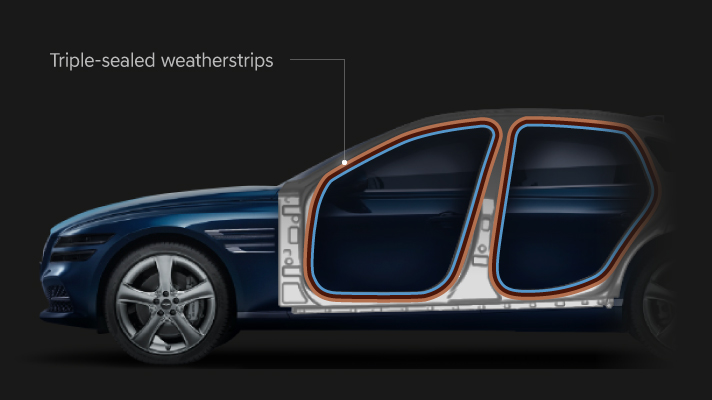
All doors of the G80 were triple-sealed with weatherstrips to reduce the noise from the wind. Competing models from other manufacturers triple-seal the part where the lower part of the door meets the window glass, but often only double-seal the rest. While this does cut the costs of production, the double-sealing often is ineffective in perfectly safeguarding the interior from external noise. The 3rd-gen G80 does not attempt to cut costs here: it triple-sealed all the edges where the door meets the car body. In addition, it applied double-bonded soundproof glass on all vehicle windows (front and rear windshields, and front and rear side windows), reducing the entry of unwanted external noises.
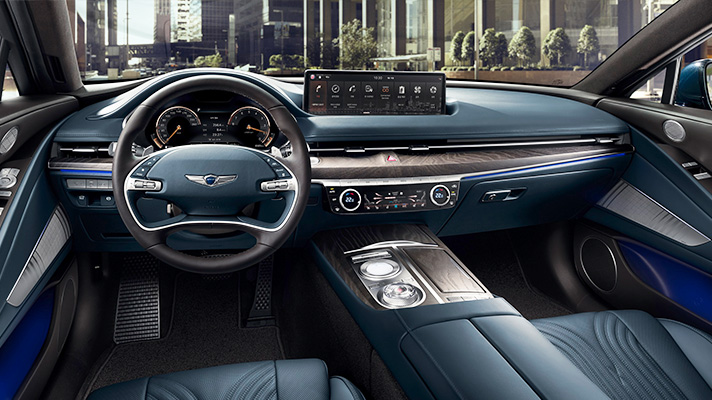
Another NVH technology targets the noise from the engine room. Genesis’s 3rd-gen platform comes with an elongated heater hose structure that inadvertently delivers noise from the engine, and the new technology manages to limit this delivery. The heater hose, connecting the engine and the car dash, is one of the main ways by which the engine’s vibration is conveyed to the cabin. The hose, made of rubber, had been elongated for improved heat insulation.
It’s also noteworthy that the engine room’s dust cover is now mounted on 4 points, as opposed to the 3 points of the existing mounting methods. The dust cover is the part on the dash panel through which the steering mechanisms (e.g. the wheel) penetrate; mounting it on 4 points allows the sealing pad to more stably adhere to the dash panel, improving the vehicle’s NVH performance. The part where the dust cover meets the dashboard is also sealed with the optimized sound-absorbing material to minimize the noise from the engine.
Finally, the 3rd-gen G80 comes with the Active Sound Design (ASD) feature that contributes to the driver’s sensual enjoyment. Under this feature, pre-tuned virtual engine noise is played back to the driver, which changes according to the current driving mode (Eco, Comfort, Sports). While there are no practical gains from this feature, it does add to the sensual pleasure of driving. And the various NVH technologies mentioned above allows for this virtual noise to properly amuse the passenger’s ears.
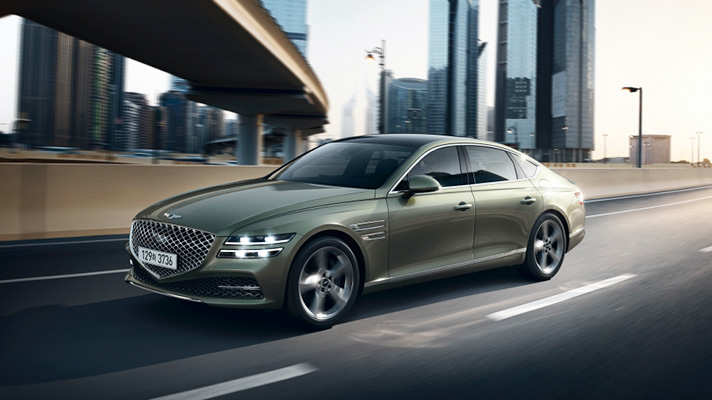
We have reviewed the technologies that avail the 3rd-gen G80’s best-in-the-tier handling, ride comfort, and NVH performance―but the excellence of the G80’s driving performance does not end in just these three aspects. The new powertrain and the brake system that react more quickly to the driver’s intents also contribute to the G80’s revamped driving performance. Though these improvements are not apparent in the facade, the drivers will know once their hands are on its handle: the 3rd-gen G80’s driving performance is simply now better than ever.